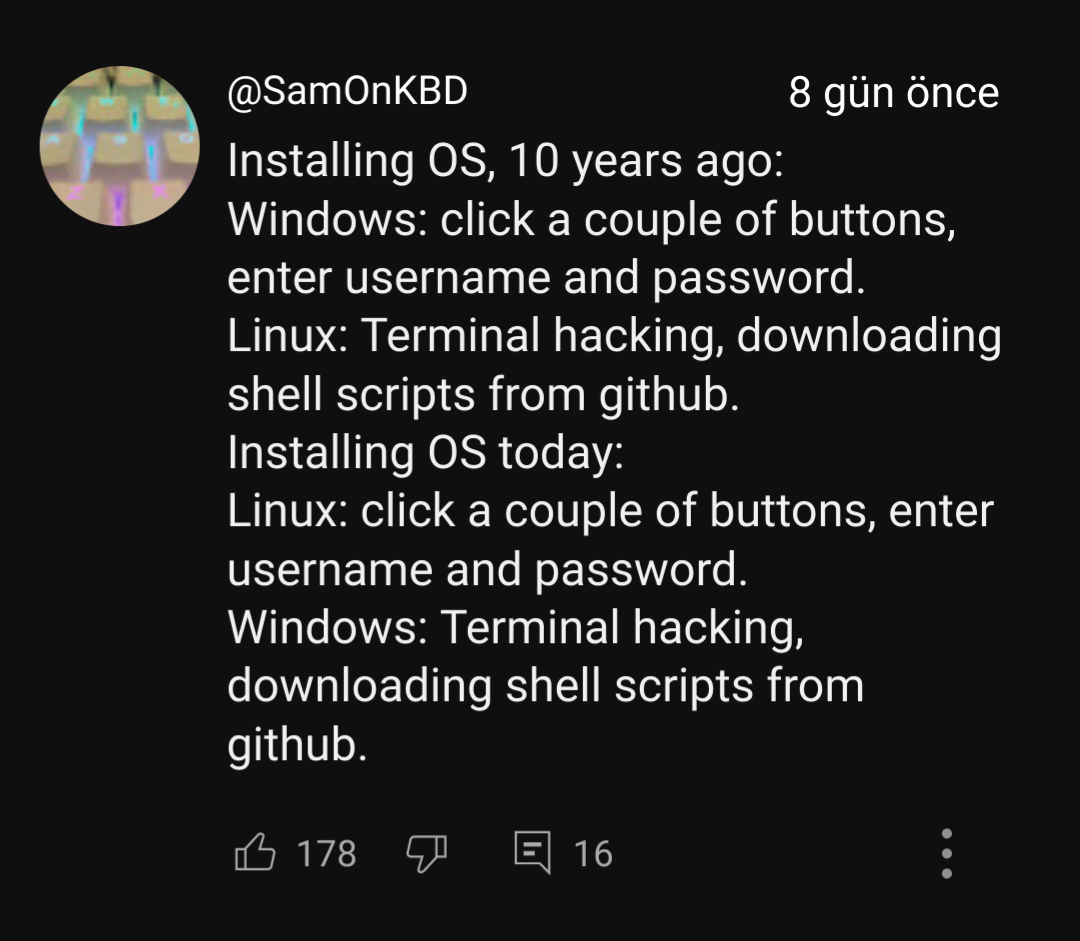Installing OS, 10 years ago:
Windows: click a couple of buttons enter username and password
Linux: Terminal hacking, downloading shell scripts from github
Installing OS today:
Linux: click a couple of buttons, enter username and password
Windows: Terminal hacking, downloading shell scripts from github.
Link to video: https://m.youtube.com/watch?v=qKRmYW1D0S0



Idk, installing Linux was pretty easy 10 years ago too. Can’t comment about anything earlier than that though.
They are probably like me, thinking that the year 2000 was 10 years ago.
This is patently absurd, 10 years ago was 1994.
Hi everyone, I’m not even a year old!
Stop, I can feel my bones crumbling to dust!
And I don’t think GitHub existed in 2000. Probably even git.
Yeah, it was SourceForge and SVN.
Around that time I moved from a company that was using perforce to one using cvs.
Git was released in ‘05, GitHub ‘08.
Removed by mod
Even 20 years ago Linux was easier to install then Windows.
Last time I recall Linux being tricky was like late 90s.
Giving you, if you were lucky, VESA graphics and maybe a mouse pointer because XFree86 somehow insisted on being told whether you have a PS/2 or USB mouse. 3d acceleration only with nvidia and that required manual installation because nvidia never provided anything but blobs. IIRC ATI drivers were simply non-existent (didn’t have an ATI card back then), that only changed when AMD bought them. Whippensnappers won’t believe it but once upon the time, nvidia was actually the company to go with when running linux. And Epic didn’t hate Linux yet, UT2004 came with linux binaries on the dvd.
I once tried to install Linux around then, not long after ISA cards with Plug n Play became a thing.
Linux: So now to even pretend to get the card to work you have to download and run a tool to generate a config file to feed to another tool so you can then install the driver and get basic functionality from the card (which is all that’s available on Linux). Except the first tool doesn’t generate a working config file - it generates a file containing every possible configuration your hardware supports hypothetically having and requires you to find and uncomment the one you want to actually use. Requiring you to manually configure the card and thus kinda defeating the point of Plug n Play (though I guess that configuration was in software, not by setting jumpers).
Same card in Windows at the time: Install card, boot Windows. Card is automatically identified and given a valid configuration, built in drivers provide basic functionality. Can download software from manufacturer for more advanced functionality.
That soured me on Linux for a long time. Might try it again sometime soon just to see what it’s like if nothing else. ProtonDB doesn’t have the most positive things to say about my Steam collection, and I imagine odds are worse for stuff not available on Steam.
Get yourself an old lenovo laptop t440p/t480. You’re missing out.
If you ask around or search, you can get answers easily. You can install games from Epic, Ubisoft etc. using other Linux applications.
Like Heroic for GOG And Epic, Lutris for everything else.
Yeah, all my Linux installs after about 2003 were liveCDs. I used to carry my Gentoo CD around as my diagnostic tools for a while helping people fix their windows machines (or just backing up everything off it before reformatting).
I think Knoppix was the first live CD I used. It was mind blowing. Now you can just carry around a whole personally configured system on a USB stick. Pretty cool.
And then you find ventoy…
I was going to say “but ventoy only mounts the filesystem as readonly. Great for testing new distros, but not great for rolling installs you carry with you to use on different computers”
Then I quickly found https://www.ventoy.net/en/plugin_persistence.html, so TIL!
good
Solid.
20 years ago was still xorg.conf times
Have you met Anaconda?
But no, you’re right…
That was the case even 19 years back. Ubuntu nailed it back then. You could install it without knowing anything about your computer. Before that, there were text based UIs which required deep understanding and lots of decisions.
It hasn’t change since mid-2000s if you only talk about the installation process itself. Usually you would have at least some piece of hardware that wouldn’t work out of box and it used to be a lot of work until getting everything in place
NDISWrapper used to be the worst.
Nvidia was also more painful than now.
Nvidia has become pretty painless in the last few years. A year ago a guy told me to try wayland so I did and surprisingly I’ve been on wayland ever since on my desktop. The last time I don’t think I was even able to see my desktop. Now the 555 drivers made things even better.
Removed by mod
Winmodems
Modems in general were either entirely PnP or a total goddamn nightmare in my experience. There was no in between. I remember setting up Slackware in the late 90s and my serial modem just worked. Even after I changed it, it worked. Even after I installed an internal modem, it worked. A few years later I set up Debian or one of its kids (probably knoppix, but I won’t testify to it) and couldn’t get a modem to work to save my life. It was so bad that I just didn’t use any Linux until I got DSL.
Edit: a couple of letters
I remember the Slackware dozens of floppies install, things have gotten stupidly easy with time